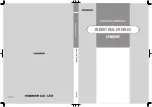
Engine Accessory Removal
Remove the hoses, electrical connections,
sensors, switches, intake manifold, and intake
manifold gaskets.
Note: The rubber coated metal gaskets are
one-time use only.
Remove dipstick tube and then remove the
water pump and rubber coated metal gasket.
The gasket is one-time use only. Retain the dust
seals for later reassembly.
Remove the oil pump. Observe the condition and location of the o-ring seal and
the dust seals. Retain the dust seals for later reassembly.
Cylinder Head Removal
Loosen all head bolts in the reverse order of the tightening sequence, and then
remove all of the cylinder head bolts except #1. Lightly tap the cylinder head with a
rubber mallet to loosen the head from the gasket. Then remove #1 bolt and the cylin-
der head with the head gasket. Repeat the above steps for the other cylinder head.
Note: The head gaskets are carbon composition with integrated o-rings. The
gaskets are interchangeable from left to right on N/A engines only.
Note: It is not necessary to remove the valve cover while removing the cylinder
head unless servicing of the valve components is required.
Oil Pan Removal
Remove the oil pan bolts. Use a thin gasket scraper/putty knife and a rubber
mallet to loosen the oil pan. Remove the oil pan. Notice the location of the oil seal
for the drain tube. Remove the oil pick-up tube and also note the o-ring. Remove
the oil pan baffle plate (windage tray).
Piston Pin Removal
Use piston pin remover 499097300 or 499097500
to remove the piston pin. Insert the tool 3/4 of the
way into the pin and pull the tool with the pin
through the access hole. Repeat for the remaining
pistons. Finally, rotate the crankshaft to position the
pistons at the top of the cylinders. Repeat the proce-
dure for the other cylinders.
Note: Use caution while rotating the crankshaft
to prevent the connecting rod large ends from dam-
aging the lower cylinder bores.
Hidden Crankcase Bolts
To split the crankcase remove all 16 of the
crankcase bolts. Six of the bolts are hidden in the
water passages, four in the RH case (1-3 side) and
two in the LH case (2-4 side).
Note: All six of the hidden shouldered crankcase
bolts have sealing washers. These bolts are not inter-
changeable with the other crankcase bolts. The sealing
washers are one-time use ONLY.
Carefully separate the crankcase halves.
Note: Identify the location of the four O-rings
(three small, one large), in the mating surface of the
right (1-3 side ) crankcase. The black o-rings are for oil
passages, the orange o-ring is for a coolant passage.
End W
rench
Th
e
10
Subaru 2. 2 Liter Engine
Intake Manifold
Removing Cylinder Head
Removing Oil Pan
Removing Wrist Pin
Hidden Crankcase Bolts And
Sealing Washers
Crankcase O-Ring Seals
































